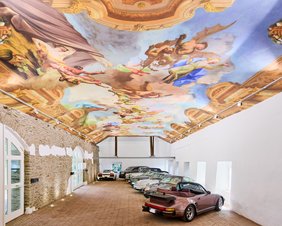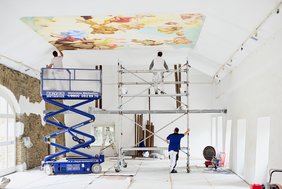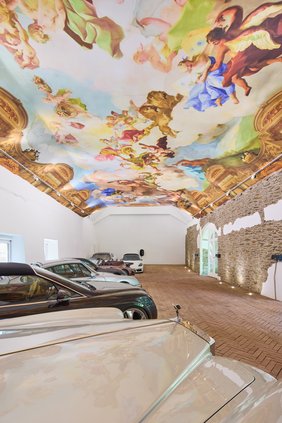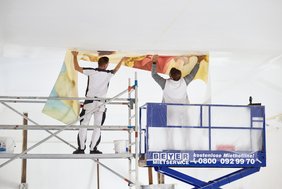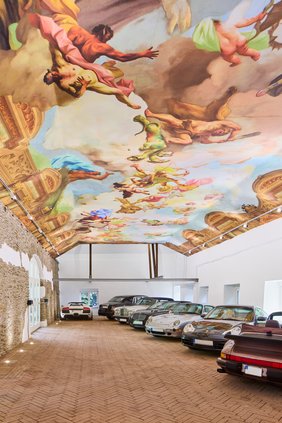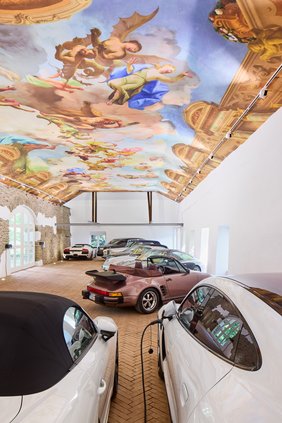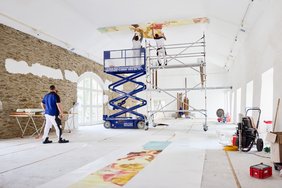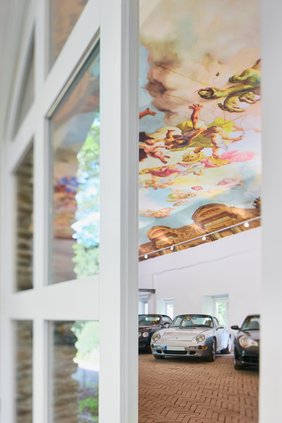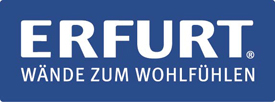Without a doubt, enthusiasts and collectors of vintage cars can count themselves lucky if they can store their treasured vehicles in a prestigious location and close to their own home. This was the case in central Germany, where a collector of vintage cars arranged for an entire building to be converted for the safe storage and presentation of his valuable vehicles. Erfurt digitally printed wallcoverings were also to be applied to the ceiling. The building is a listed building and has already been many things in its lifetime: for many years it was the small town's cinema. The historic building was renovated with great care - in the interior, the installation of a dry wall false ceiling formed the basis for its planned new use.
A fresco above the cars
The client harboured a desire to incorporate the ceiling in the design of the showroom. The initial considerations for simple decor stucco trims soon developed into the idea of decorating a ceiling spanning almost 190 square metres with a large image in the style of a historic fresco. Owing to his previous positive experiences, Marco Müller, the master decorator for the decorating company involved with the project, Michel GmbH, suggested Erfurt digitally printed wallcoverings. “Erfurt prints on nonwoven wallpaper - you are free to choose the type. And when you no longer want an image, you can simply paint over it and achieve a perfectly smooth surface.” The client found a photo of their perfect baroque ceiling painting online. The fresco, painted in 1731 by Paul Troger, can be found in the Marble Hall of Melk Abbey in Austria. The reason: there is a vehicle at the centre of the allegorical painting showing the goddess Palla Athena on a carriage drawn by lions. After acquiring the image file from an image archive and clarifying the usage rights, Marco Müller then got in touch with Erfurt. Sven Dörfling, Sales Manager and Professional Customer Consultant for the Wuppertal-based manufacturer, immediately recognised the unique nature of the project and brought additional specialists on board. Kai Pommerening, an experienced application engineer, strengthened the wallpapering team from the start.
From initial idea to completion
The image file was checked by Erfurt to determine whether it could be scaled up - any pixels or troubling elements that might become visible down the line had to be reliably removed due to the massive enlargement of the image. The image was then printed on ERFURT-Variovlies M 160 PRO, spread across 28 rolls, each 10 m long. After the room survey had confirmed that none of the walls were perpendicular and that the ceiling also tapered from 6 m to 5 m, 'Team Fresco' was formed to work out the approach together. All the surfaces were first treated with a pigmented base coat to equalise absorption. The temperature in the unheated room was raised to 15-18 degrees Celsius with a fan heater to create the optimum working conditions. Due to the lack of reference points, it was decided to adhere the image from the centre of the room outwards towards the sides. The centre of the room was determined using a cross-line laser. The decorators stood on moveable scaffolding when wallpapering. ERFURT-Variovlies is applied using a paste-the-wall technique - and Erfurt also recommends using a special nonwoven adhesive for this. However, due to the size of the image, the fact that it was being adhered to the ceiling, and the lack of heating, the wallpapering team decided to use a particularly strong and moisture-resistant emulsion adhesive (Capacoll GK), to be on the safe side.
Perfectly equipped for team work
The wallpapering work took around one and a half days to complete (plus another one and a half days for preparation and final work) with three decorators. While two stood on the moveable scaffolding and applied the adhesive above their heads, positioned the nonwoven lengths, and then worked them into the bed of adhesive with rubber rollers, the third person looked after everything else at floor level. The rails between the pitched roof and the beams (magic corners) were also consciously wallpapered over, unlike the standard practice. The wallcovering was cut and precisely adjusted to the tapered ceiling after the lengths had been applied.
The edge, which was not fully covered, was easily hidden with parts of the image (clouds) that had been cut off. All aspects of the final result delighted the client. Thanks to the fortunate choice of image, perfect craftsmanship and atmospheric lighting, the ceiling painting looked as if it had been painted exclusively for use in the vintage car garage. Both the client and the craftspeople involved were delighted with an all-round successful and unique project - and rightly so!
Find out more about Erfurt digitally printed wallpapers here.
